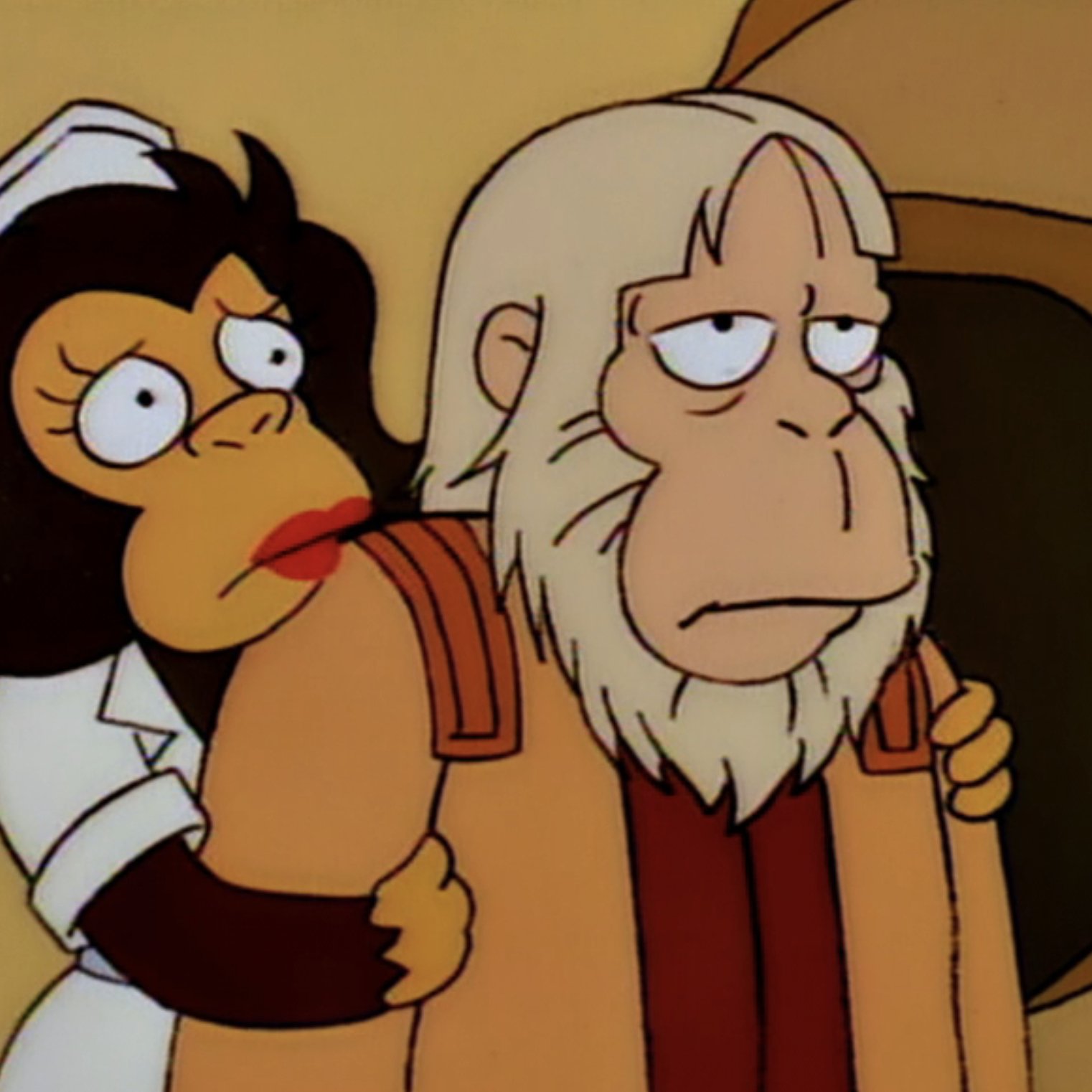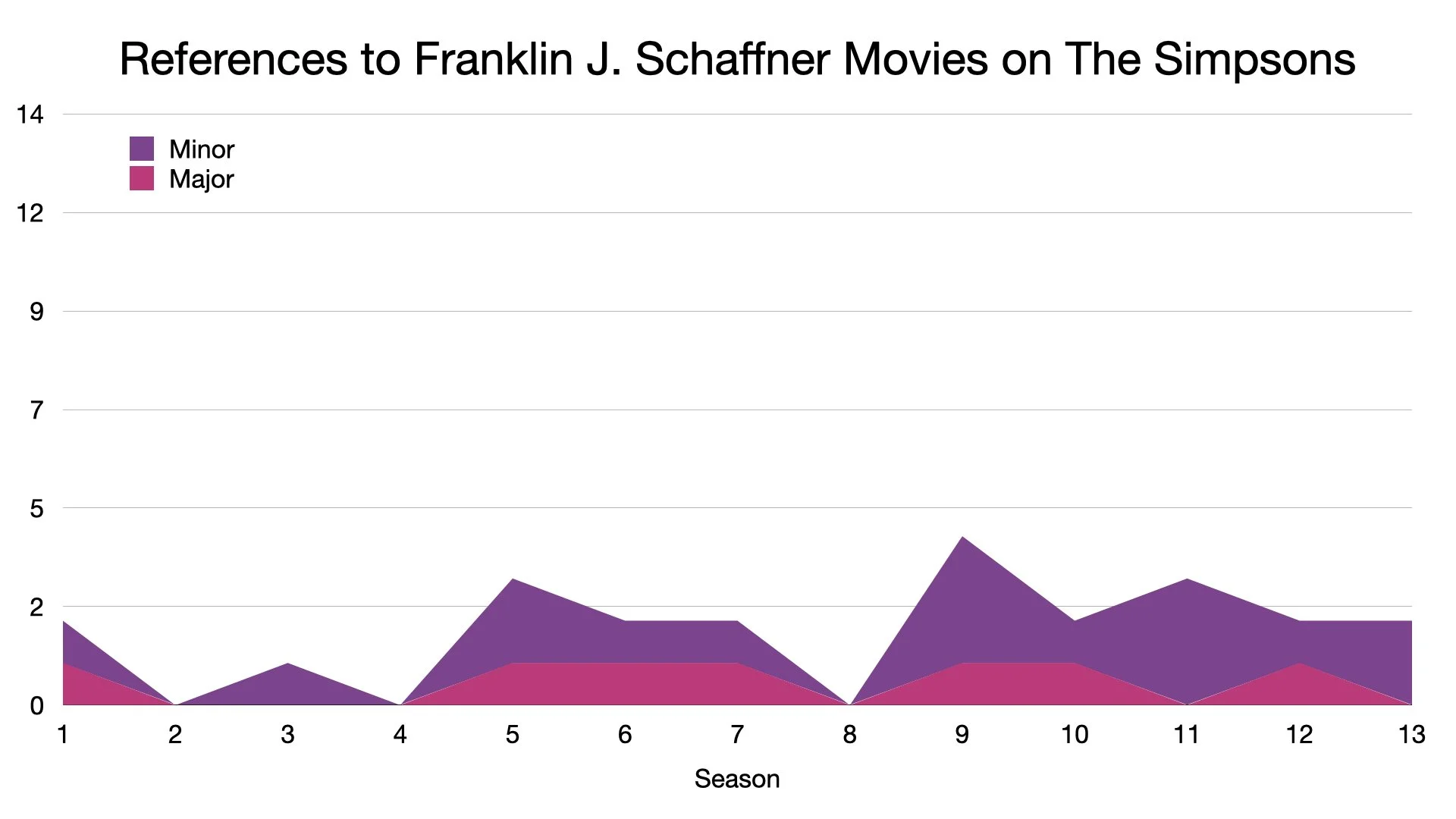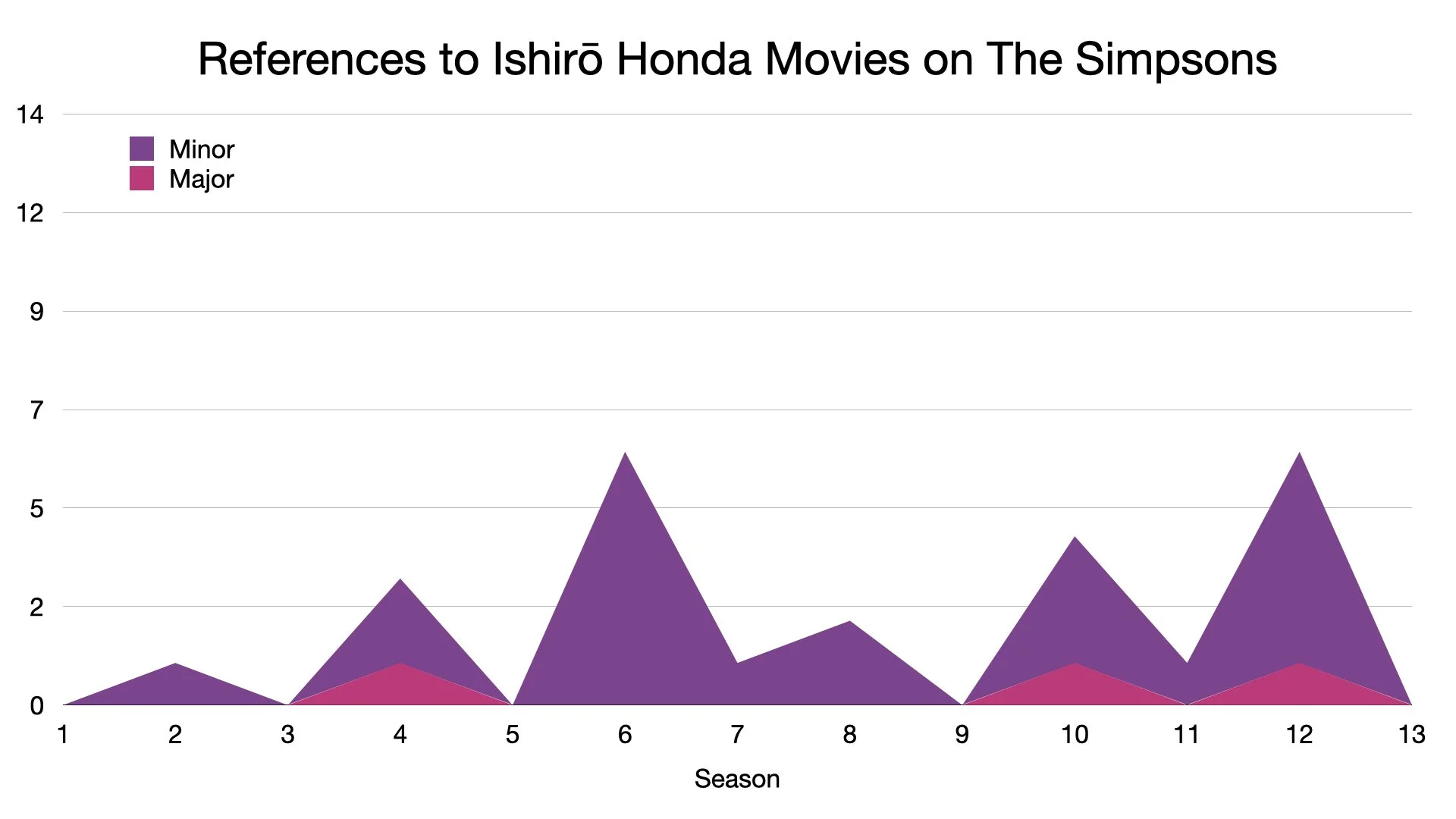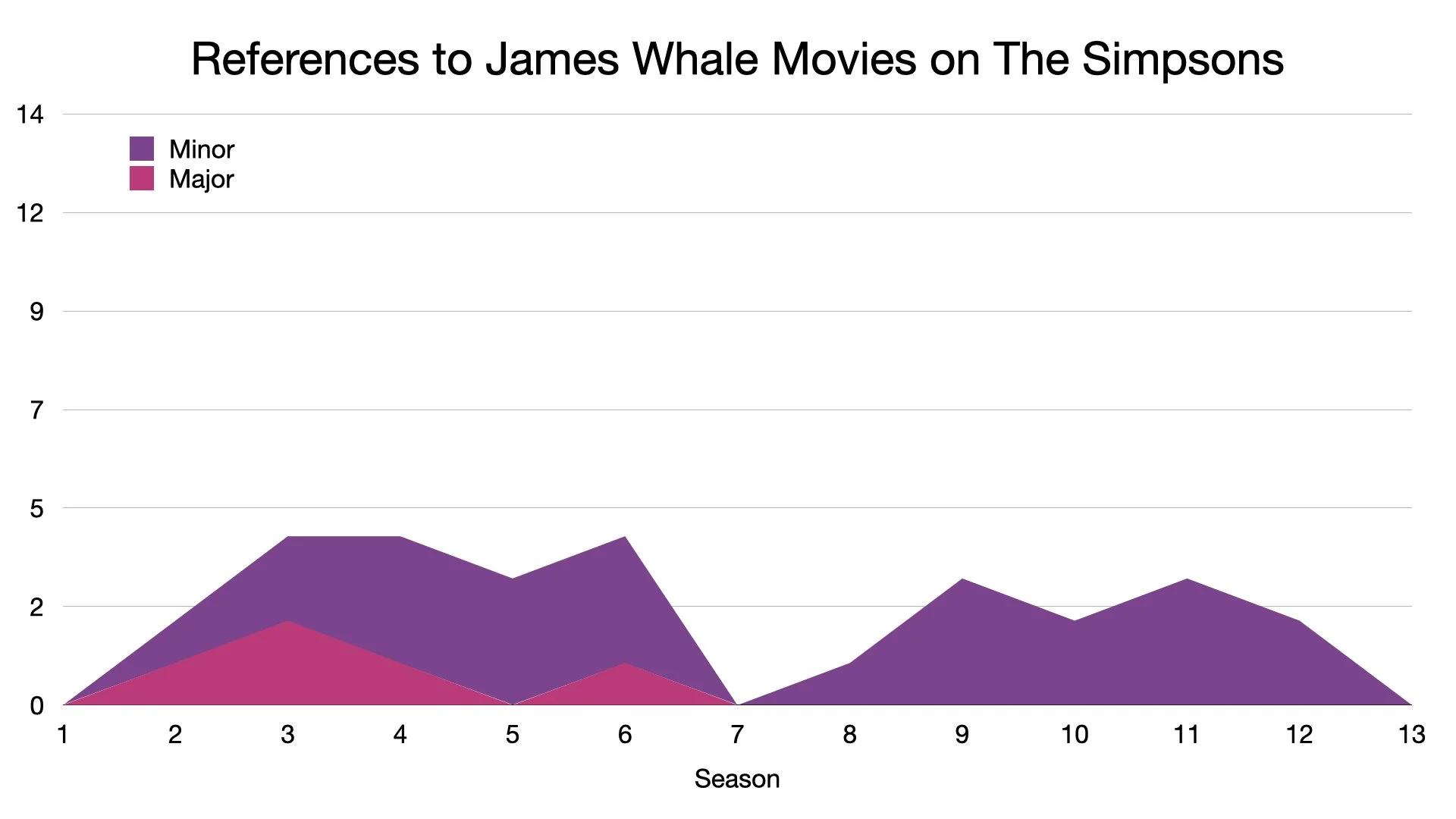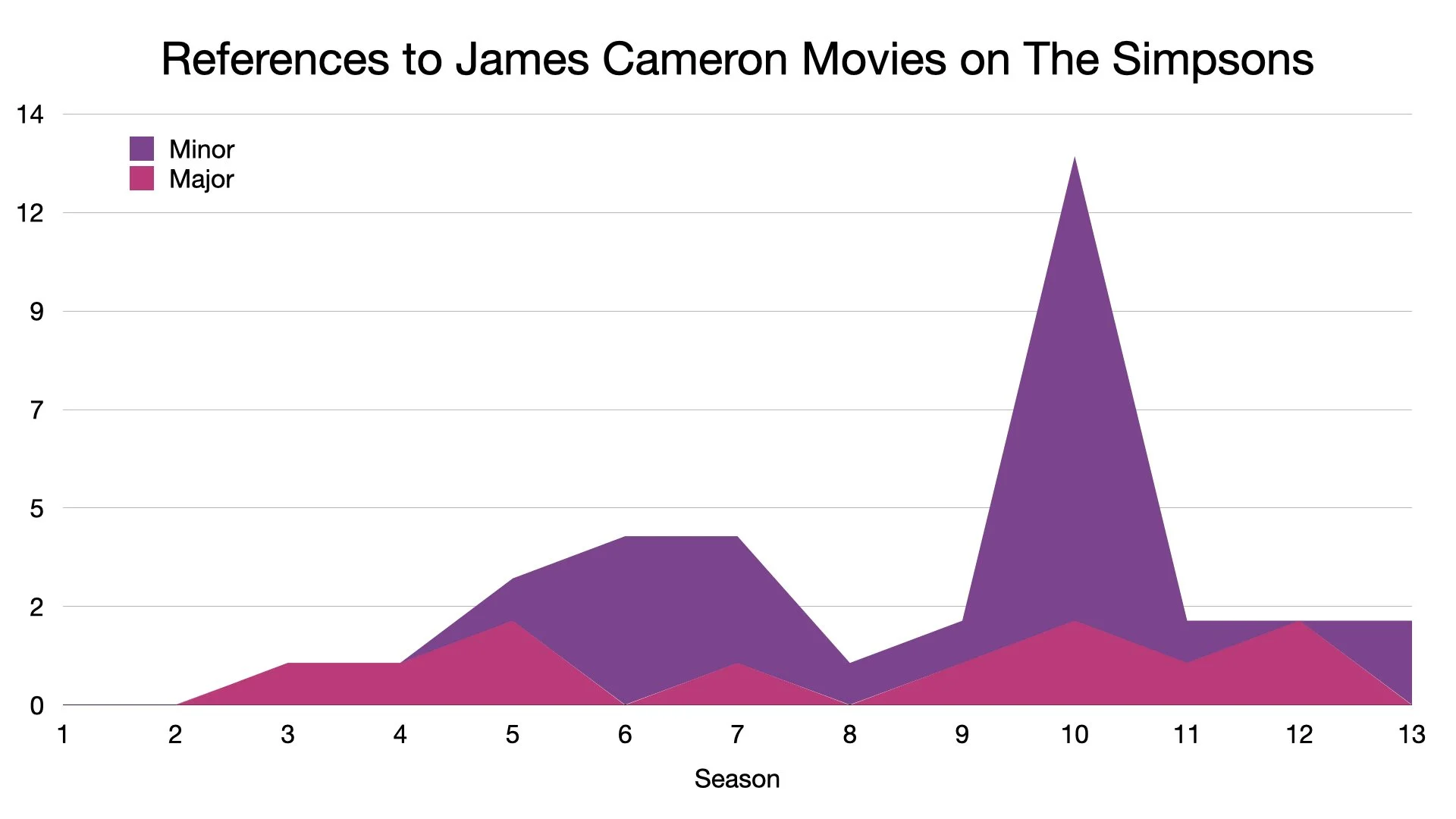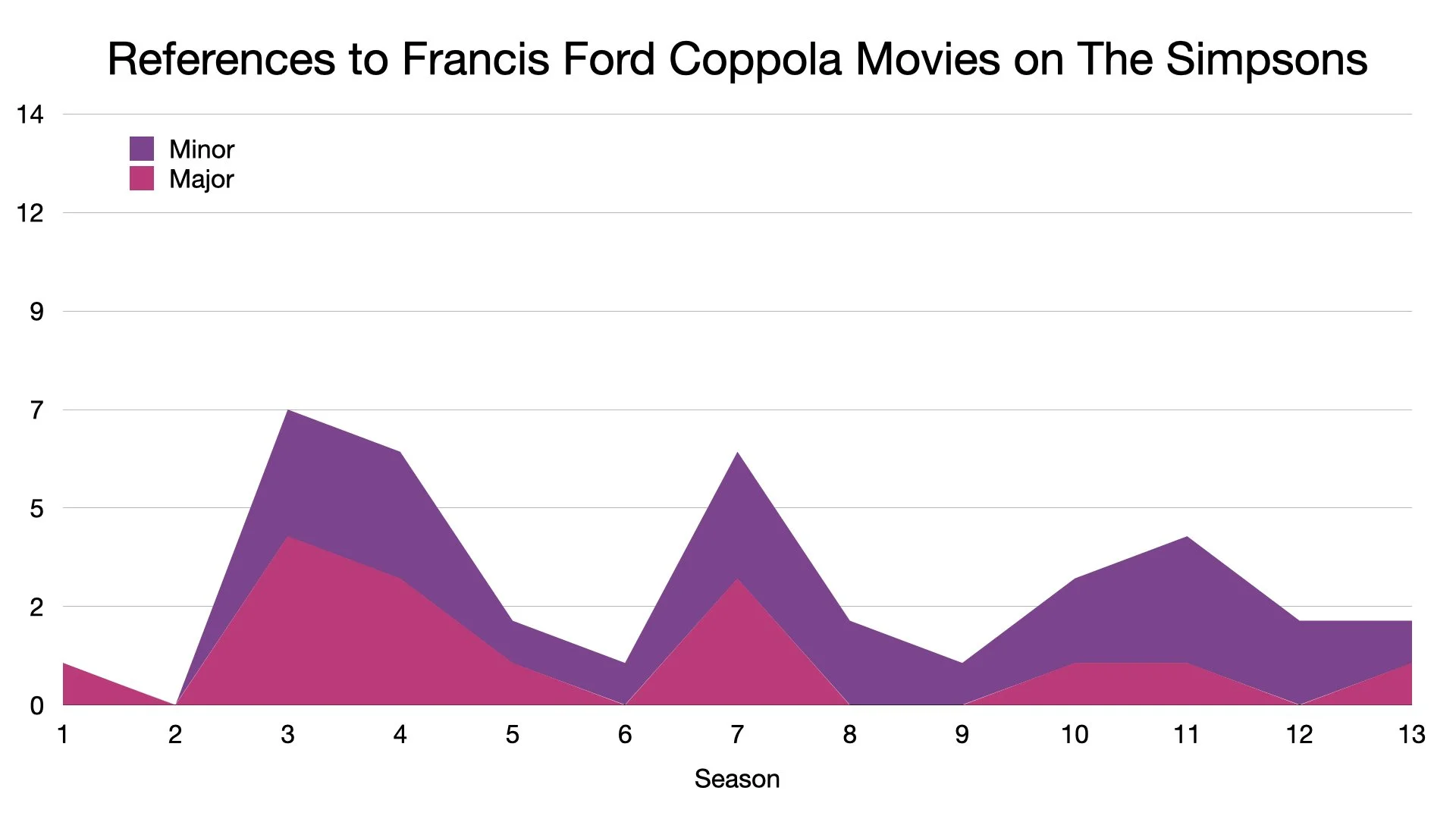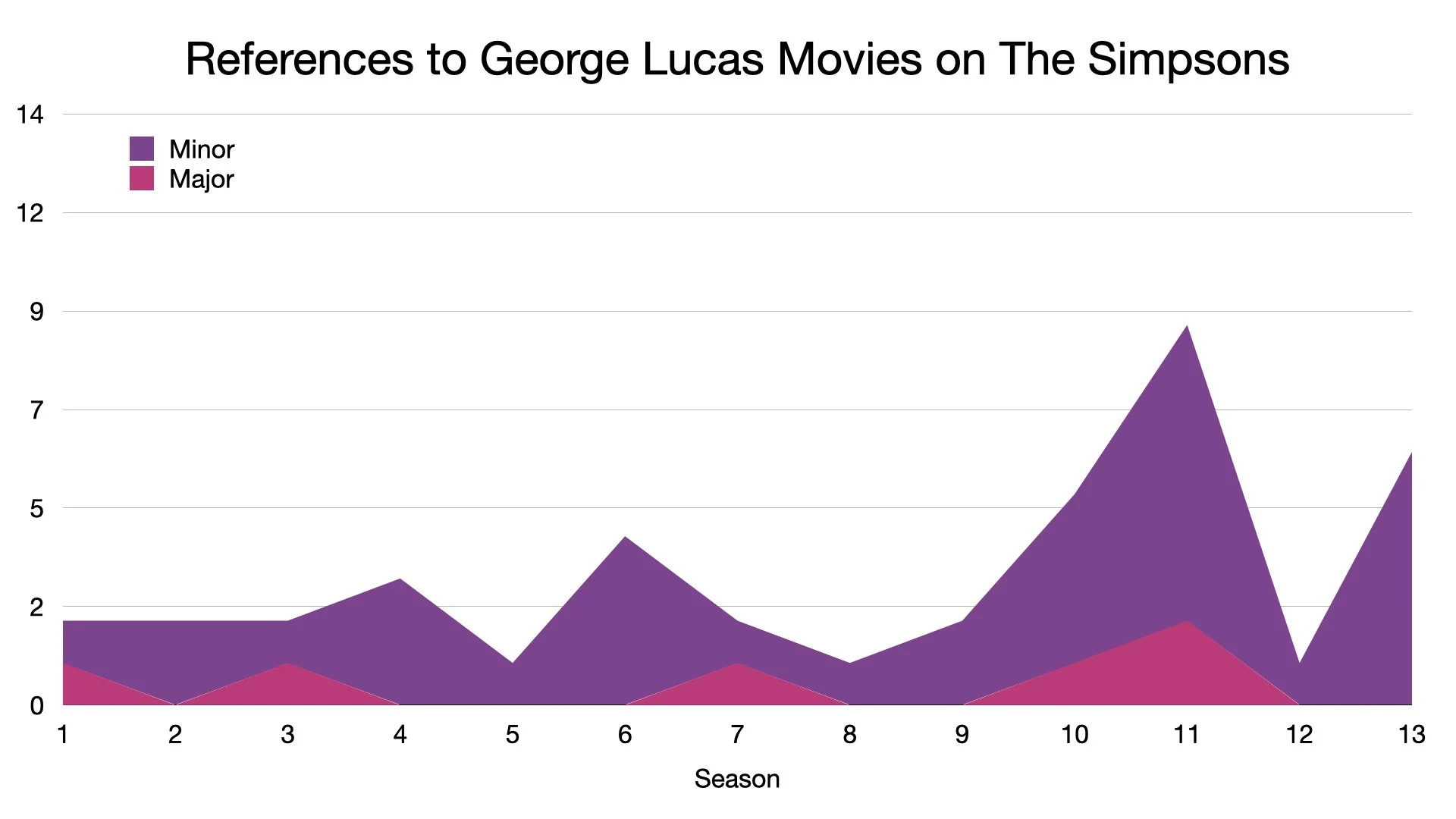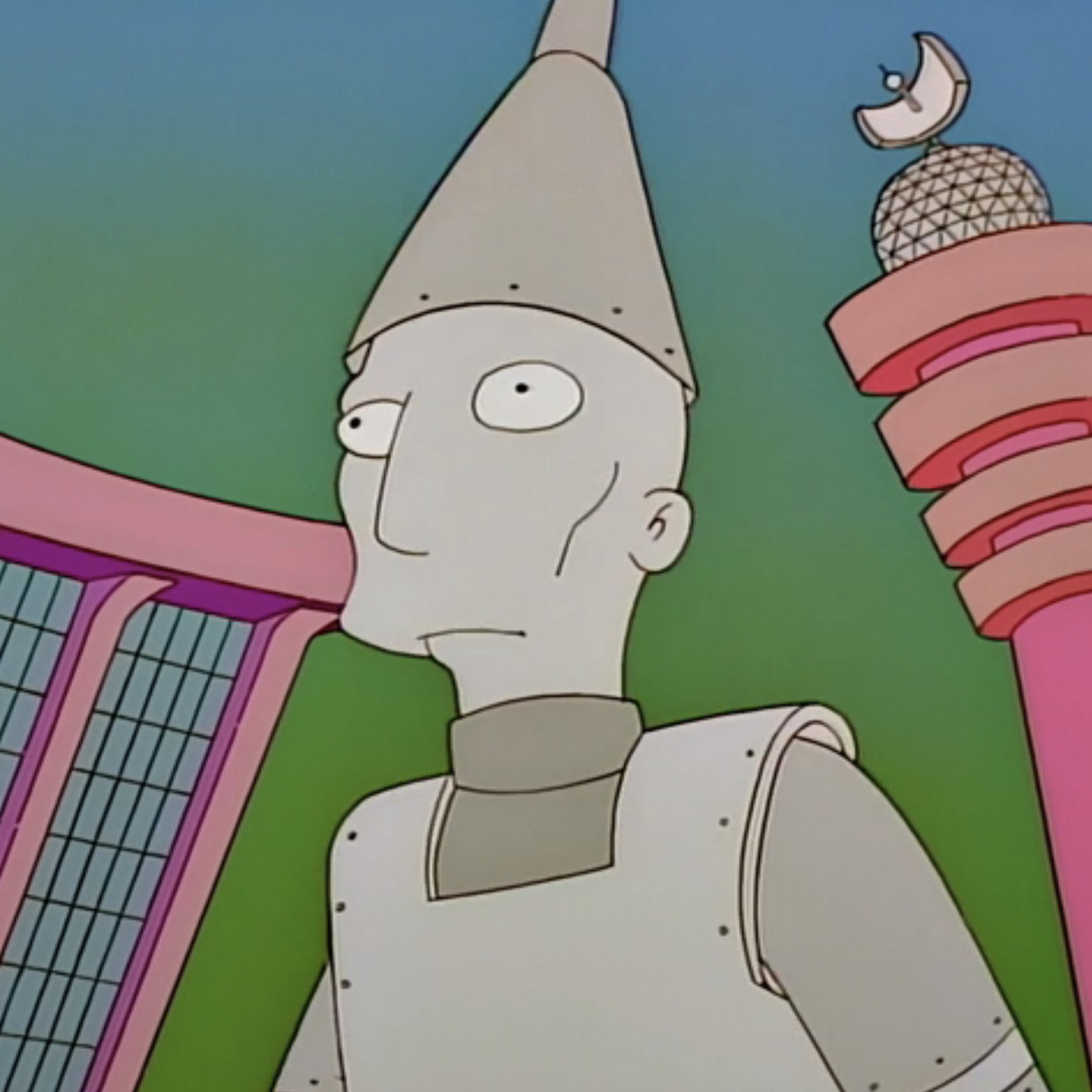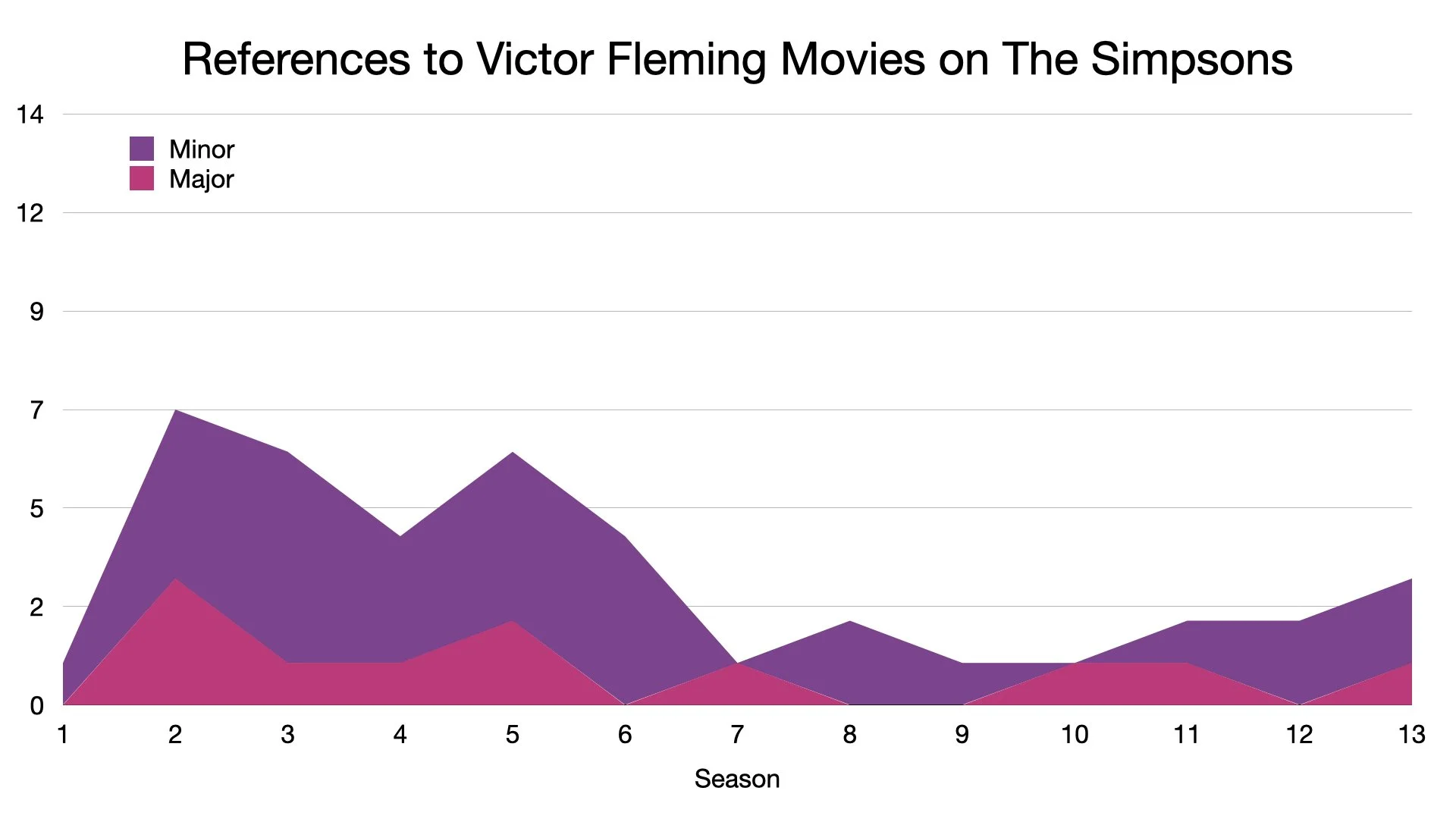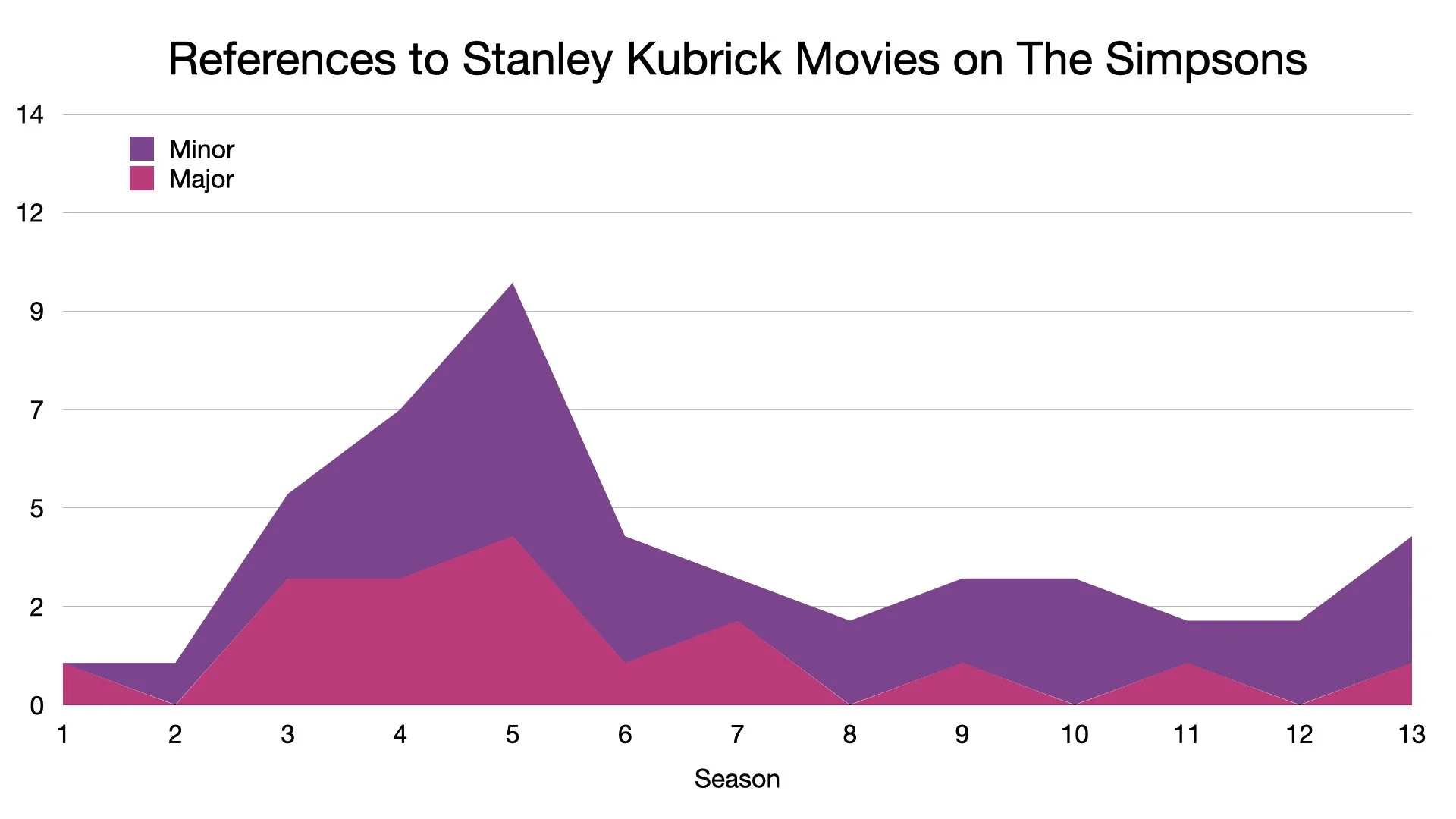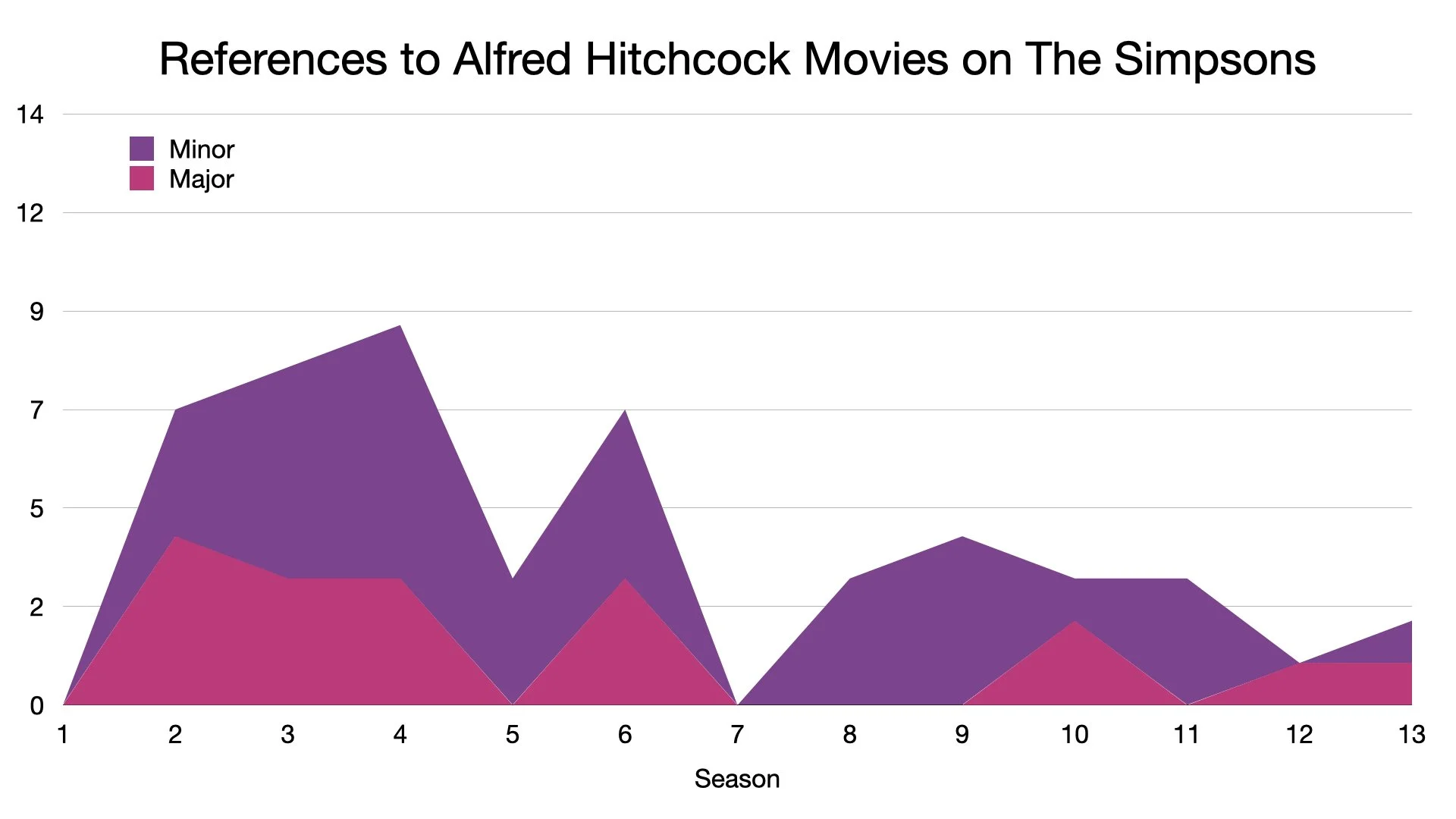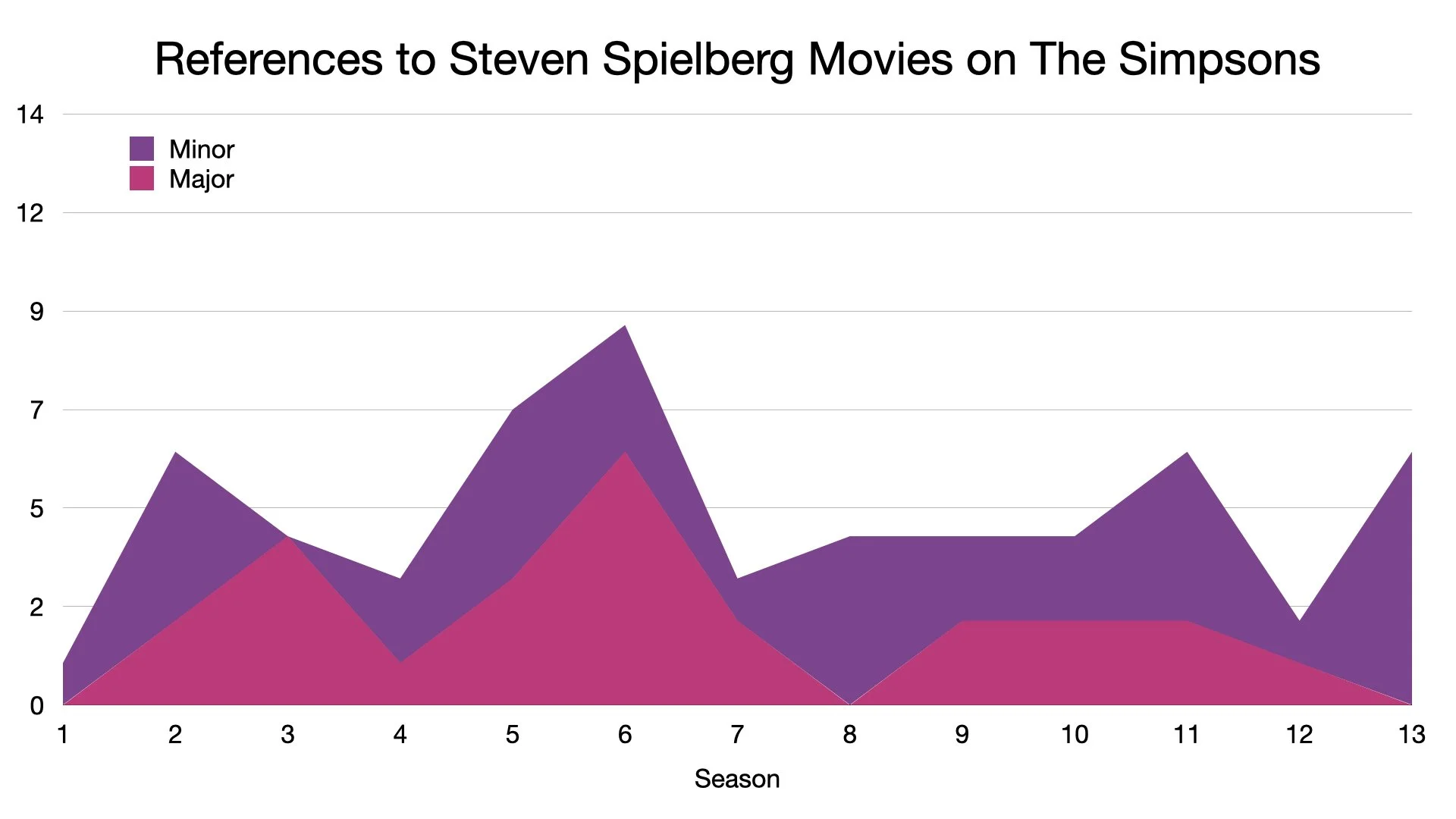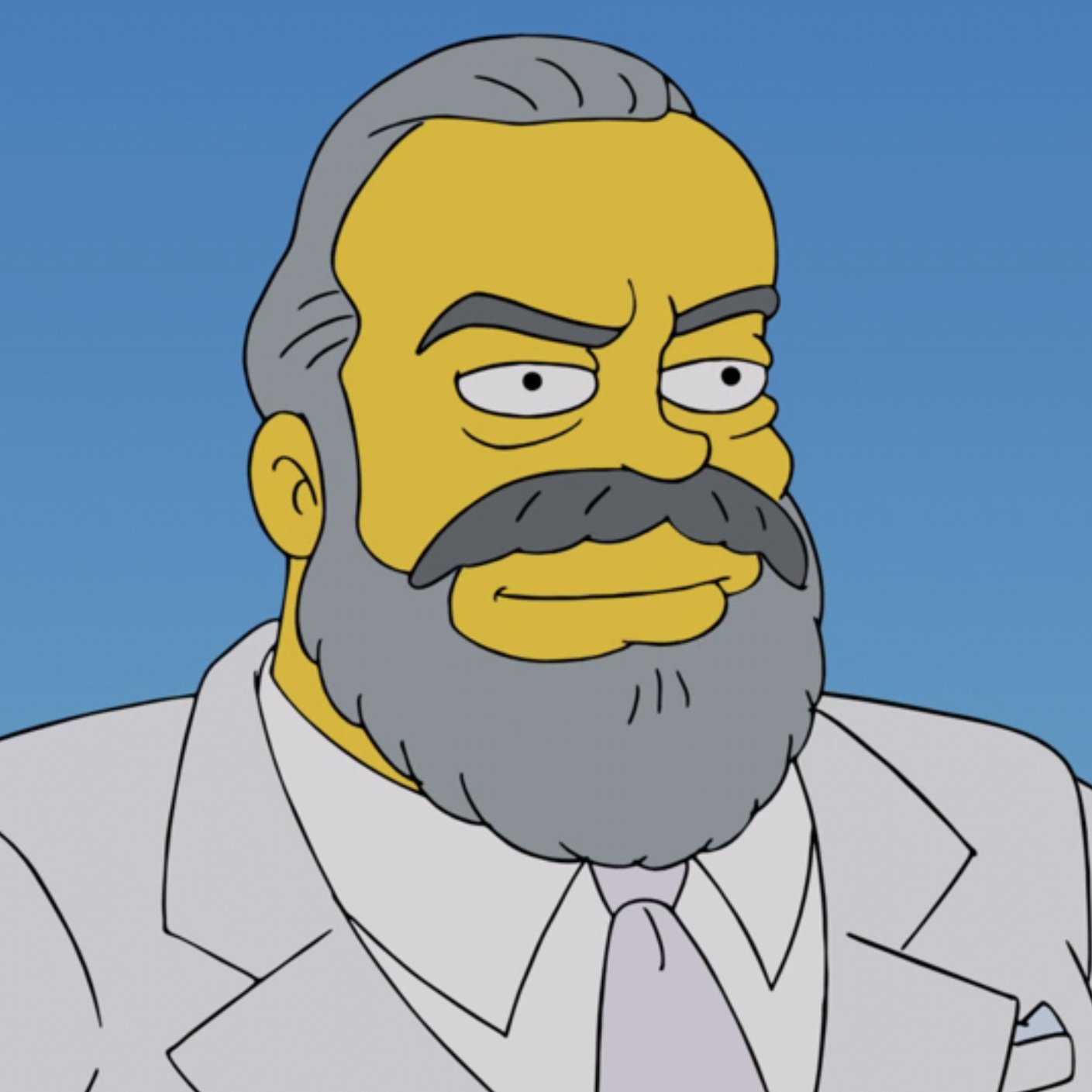The Top 10 Most Referenced Directors on The Simpsons
The writers and animators behind The Simpsons are not only movie fans, but also fans of particular directors. Auteurs like Alfred Hitchcock, Stanley Kubrick, and Orson Welles have even been depicted on the show!
But when we count up all of the movie parodies and homages, who are the directors that are referenced the most on The Simpsons?
In this article, we rank the most frequently referenced directors in the first 13 seasons of The Simpsons, based on our Simpsons Movie Reference Database (SMRDb). For each director, we break down every movie referenced, plus the biggest omissions from their filmographies.
10. Franklin J. Schaffner
Total References: 23
Major References: 7 (30%)
Films Referenced: 3/19 (16%)*
Unlike many of the directors on this list, it’s hard to call Franklin J. Schaffner (1920-1989) an auteur. The range of his work is broad, from science fiction to period pieces to action movies and thrillers.
While the first few references to Schaffner are to his Best Picture-winning film Patton (1970), starting in season 5 under showrunner David Mirkin, Planet of the Apes (1968) becomes a staple of the show. While most fans will remember Troy McClure’s musical adaptation “Stop the Planet of the Apes, I Want to Get Off!”, perhaps the most enduring parody is a score soundalike from the flash-forward ending of “Rosebud” (S5E4). This score became The Simpsons’ go-to music for any kind of mob scene for years to come.
Most Referenced Movie: Planet of the Apes (1968), the #7 most referenced movie in the first thirteen seasons of The Simpsons.
First Reference: ”Bart the General” (S1E5). There are several references to Patton (1970) in this episode, including use of the real score (since it was owned by Fox), a parody of the famous slapping scene, Herman discussing the Greeks and the Carthaginians, and even Grampa Simpson calling General George S. Patton “a little nuts."
Plot Parodies: None.
Deepest Cut: The Boys from Brazil (1978). In “Lard of the Dance“ (S10E1), Marge says a baby can't organize a school dance unless it was "one of those super-babies from Brazil." This film involves a Nazi conspiracy to create clones of Hitler in Brazil.
Other Movies Referenced: None.
Biggest Omission: Papillon (1973). This is the prison escape movie starring Steve McQueen that’s not The Great Escape (1963). They’ve parodied that one a few times, so why not this one?
Listen on the Podcast:
All Franklin J. Schaffner Episodes
9. Ishirô Honda
Total References: 24
Major References: 3 (13%)
Films Referenced: 3/75 (4%)*
The only director of non-English-language films on this list, Ishirô Honda (1911–1993) was the Japanese father of the kaiju genre, beginning with his groundbreaking movie Godzilla (1954) and continuing with dozens of others throughout his career.
References to Honda started early in the series and remained fairly consistent, but the release of Roland Emmerich’s Godzilla (1998)—which features multiple members of the Simpsons cast—may have contributed to his biggest peak in season 12. Honda also sometimes racked up multiple references in one episode, when kaiju from his various Toho movies appear together.
Most Referenced Movie: Godzilla (1954), the #8 most referenced movie in the first 13 seasons of The Simpsons.
First Reference: “Bart Gets an ‘F’” (S2E1). This marks the first appearance of a Godzilla-like figurine in Bart's room.
Plot Parodies: None.
Deepest Cut: Gamera, the Giant Monster (1965). This is a bit of a cheat since it’s not a movie directed by Honda, but two of the references to Honda’s monster menagerie on The Simpsons also include Gamera, a knockoff of Godzilla created by a competing studio. Is this an Easter egg or an oversight?
Other Movies Referenced:
Rodan (1956)
Mothra (1961)
Biggest Omissions: King Kong vs. Godzilla (1962). Given the many references to King Kong (1933) on the show, this seems like a no-brainer.
Listen on the Podcast:
All Ishirô Honda Episodes
8. James Whale
Total References: 28
Major References: 5 (18%)
Films Referenced: 3/21 (14%)*
From one of the more contemporary directors on the list, we turn to one of the oldest. Similar to Honda, James Whale (1889–1957) was one of the founding fathers of the monster movie genre, directing one of the earliest entries in the Universal Monsters franchise, Frankenstein (1931).
However, Whale’s greatest contribution to The Simpsons must certainly be Marge’s tall blue hair, which is famously inspired by Elsa Lanchester’s iconic hairdo in Bride of Frankenstein (1935) combined with the 1960s beehive of Matt Groening’s mother. The show even gives a nod to these origins in several “Treehouse of Horror” episodes, giving Marge black hair with a white bolt up the side.
References to Whale saw their peak in season 2 and 3 with the beginning of the “Treehouse of Horror” series, which included an opening warning taken from Frankenstein and a full plot parody in one segment. However, momentum continued throughout the first 13 seasons, mostly thanks to many writers opting to integrate “Frankenstein” into their names for the annual “Treehouse of Horror” episodes as creepy credit fatigue set in.
Most Referenced Movie: Frankenstein (1931), the #4 most referenced movie in the first 13 seasons of The Simpsons.
First Reference: ”Simpsons Roasting on an Open Fire” (S1E1). Marge first appears on the show with her tall hair inspired by Bride of Frankenstein (1935).
Plot Parodies: Frankenstein (1931) in “Treehouse of Horror II” (S3E7).
Deepest Cut: The Invisible Man (1933). In “Mayored to the Mob” (S10E9), someone is dressed as the titular Invisible Man at Bi-Mon-Sci-Fi-Con.
Other Movies Referenced: None.
Biggest Omissions: The Old Dark House (1932). The haunted house trope has been skewered many times on The Simpsons, but what if the Simpson family were the cursed inhabitants of a haunted house this time?
7. James Cameron
Total References: 35
Major References: 11 (31%)
Films Referenced: 6/8 (75%)*
James Cameron (1954–) is the youngest director on the list by eight years, and rose to prominence alongside The Simpsons, with the The Tracey Ullman Show shorts premiering just three years after his breakout success with The Terminator in 1984.
Another acolyte of Roger Corman’s school of shoestring filmmaking, in the 1990s Cameron would ironically direct several blockbusters with record-breaking budgets, including Terminator 2: Judgment Day (1991), True Lies (1994), and Titanic (1997). Much like Scorsese, the Simpsons crew followed Cameron’s career carefully, consistently incorporating references to his new releases.
References to Cameron saw multiple peaks throughout the first 13 seasons, including a small bump after the release of Terminator 2: Judgment Day (1991) starting in season 5, and a massive bump in minor references after Titanic (1997) in season 10. Overall, Cameron’s filmography is the most completely referenced on this list, with 75% of his movies covered in one way or another, yet no single movie cracks the top ten most referenced movies on the show.
Most Referenced Movie: Terminator 2: Judgment Day (1991).
First Reference: ”Treehouse of Horror II” (S3E7). When Homer is reanimated, his computerized vision appears in red, highlighting important objects, just like the Terminator’s POV.
Arguably, a similar reference appears earlier in “Principal Charming” (S2E14), when Homer is looking for a man for Selma, but we think it seems closer to the computer vision in RoboCop (1987), and the score in that moment backs this up.
Plot Parodies: None.
Deepest Cut: Piranha II: The Spawning (1982). In “Jaws Wired Shut” (S13E9), "Chocolat 2: The Vanilla-ing" appears on the marquee of the Springfield Googolplex (the place, not the podcast).
Other Movies Referenced:
The Terminator (1984)
Aliens (1986)
True Lies (1994)
Titanic (1997)
Biggest Omissions: The Abyss (1989). Underwater aliens, groundbreaking visual effects, and pretensions of grandeur? A perfect “Treehouse of Horror” segment.
Listen on the Podcast:
All James Cameron Episodes
6. Francis Ford Coppola
Total References: 37
Major References: 15 (41%)
Films Referenced: 6/27 (22%)*
Much like Scorsese, Francis Ford Coppola (1939–) is most often referenced by The Simpsons for his towering contribution to the crime genre: The Godfather trilogy. Also like Scorsese, he got his start in the world of Roger Corman’s exploitation flicks, but almost half a generation earlier. As a result, he famously supported upcoming directors like Steven Spielberg, Scorsese, and Lucas, with whom he founded American Zoetrope.
But Coppola explored a range of genres that also proved great grist for the Simpsons mill, like war and horror movies, inspiring moments related to characters like Principal Skinner and Fat Tony among others.
The peak for Coppola references comes somewhat mysteriously in season 3, either because of the recent release of The Godfather Part III (1990)—although none of the references at that time are to this much maligned conclusion to the trilogy—or simply because showrunners Al Jean and Mike Reiss happened to love his films. However, after a dip in interest under David Mirkin, enthusiasm for the first two Godfather films continued under showrunners Oakley and Weisntein and Mike Scully, too.
Most Referenced Movie: The Godfather (1972), the #9 most referenced movie in the first 13 seasons of The Simpsons.
First Reference: ”The Telltale Head” (S1E8). Bart wakes up next to the head of Jebediah Springfield, parodying the famous “horse head scene” from The Godfather (1972).
Plot Parodies: Bram Stoker’s Dracula (1992) in “Treehouse of Horror IV” (S5E5).
Deepest Cut: Tucker: The Man and His Dream (1988). In “Burns Verkaufen der Kraftwerk” (S3E11), Homer’s fantasy about the land of chocolate features a soundtrack based on the score from this movie.
Other Movies Referenced:
The Godfather Part II (1974)
Apocalypse Now (1979)
The Godfather Part III (1990)
Biggest Omissions:
The Outsiders (1983). What if Bart and his friends got into a rumble with their Shelbyville rivals that went too far, and they had to hide out to avoid getting in trouble?
Peggy Sue Got Married (1986). Or what if Marge almost divorced Homer (again), and was transported back to high school to explore her options?
Listen on the Podcast:
All Francis Ford Coppola Episodes
5. George Lucas
Total References: 40
Major References: 6 (15%)
Films Referenced: 3/4 (75%)*
While George Lucas (1944–) is yet another maker of blockbusters on this list, his relationship to The Simpsons is quite different from Cameron’s. While Cameron’s Terminator franchise was thoroughly and lovingly parodied and recreated, Lucas’s Star Wars serves as wallpaper most of the time. Most often, a stray lightsaber or a mention of Obi Wan Kenobi is used as a marker of geekdom on the show.
In fact, as showrunner Bill Oakley discussed in our podcast episode on Pulp Fiction (1994), Lucas’s coming-of-age story American Graffiti (1973), and its many imitators, may have had more of an influence on the actual writing of the show.
While the Star Wars franchise is a constant hum throughout the first 13 seasons, references to Lucas saw their biggest peak in season 11, following the release of Star Wars: Episode I - The Phantom Menace (1999). Of course, if we included the Star Wars movies that George Lucas produced but didn’t direct himself, he’d appear even higher on this list.
Most Referenced Movie: Star Wars (1977), the #2 most referenced movie in the first 13 seasons of The Simpsons.
First Reference: ”Bart the General” (S1E5). In Bart’s epilogue to the episode, he says, "There are no good wars with the exception of the American Revolution, WWII, and the Star Wars trilogy."
Plot Parodies: None.
Deepest Cut: American Graffiti (1973). Despite the high number of references to the Star Wars franchise, there are more actual parodies of this coming-of-age movie, including in “Summer of 4'2” (S7E25) and “Take My Wife Sleaze” (S11E8).
Other Movies Referenced: Star Wars: Episode I - The Phantom Menace (1999).
Biggest Omission: THX 1138 (1971). As a fully-realized, Lucas-designed sci-fi world with a romance at the middle, this could make for a great “Treehouse of Horror” segment starring Marge and Homer, or maybe just a satire on working conditions at Amazon warehouses.
4. Victor Fleming
Total References: 40
Major References: 11 (28%)
Films Referenced: 2/50 (4%)*
While Victor Fleming (1889–1949) directed some of MGM’s most popular and critically acclaimed movies in the 1930s, most of his westerns, swashbucklers, and romantic comedies are far less known today.
Instead, he is primarily remembered for two massive movies from the same year that have enjoyed regular revivals throughout the years, The Wizard of Oz (1939), whose reputation was bolstered by annual TV airings, and Gone with the Wind (1939), the top-grossing film of all time after adjusting for inflation thanks to multiple theatrical rereleases.
References to Fleming started early and continued relatively consistently throughout the first 13 seasons. However, it’s not surprising that the biggest peak came under the original showrunners Matt Groening, James L. Brooks, and Sam Simon, since The Wizard of Oz (1939) is one of Groening’s all-time favorite movies.
Most Referenced Movie: The Wizard of Oz (1939), the #1 most referenced movie in the first 13 seasons of The Simpsons.
First Reference: ”There's No Disgrace Like Home” (S1E4). The episode title is a reference to Dorothy’s famous repeated lines from The Wizard of Oz (1939).
Plot Parodies: None.
Deepest Cut: Gone with the Wind (1939). While it’s somewhat outrageous to call one of the top-grossing films of all time a deep cut, this movie’s reputation took a generational hit as its sympathetic portrait of the losing side of the American Civil War has come under more scrutiny. It’s notable that references to this movie on The Simpsons drop off significantly after season 3, and increasingly become jokes about old people’s affection for it.
Other Movies Referenced: None.
Biggest Omission: Captains Courageous (1937). What if Bart fell overboard on a boat trip, and learned the ropes on a fishing vessel with the Sea Captain and his motley crew? (It also comes recommended by Steven Spielberg.)
3. Stanley Kubrick
Total References: 46
Major References: 17 (37%)
Films Referenced: 8/16 (50%)*
On The Simpsons commentaries, Stanley Kubrick (1928–1999) is often cited as one of the writers’ favorite directors. In his list of 100 favorite things, creator Matt Groening also lists Kubrick’s Lolita (1962) and Dr. Strangelove or: How I Learned to Stop Worrying and Love the Bomb (1964) collectively as #16, the fifth highest ranked film entry.
Their collective love of Kubrick shows. His striking visuals coupled with his dark, dry, crass, and irreverent sense of humor reflect many of the characteristics that The Simpsons is also fondly remembered for, especially in its early years.
A bit like Coppola, Kubrick hailed from an in-between generation of filmmakers, coming up between the old masters that made the transition from silent film to talkies and the auteurs of New Hollywood. Kubrick began working within the studio system with films like Spartacus (1960), but is best remembered and most parodied for the movies he made after fleeing to the UK for more artistic freedom, beginning with Lolita (1962). Over the years he left his mark on multiple genres favored by The Simpsons for parody, like war, sci-fi, and horror.
It’s remarkable that Kubrick is the second most referenced director in the show, yet none of his movies appear on the list of top 10 most referenced movies. More than anything, this is a testament to how broadly his filmography is parodied, compared to some directors that have only one or two massively parodied films.
References to Kubrick start early in the series, including a parody of the recently released Full Metal Jacket (1987) in season 1, and climb steadily to a peak in season 5 under Mirkin. However, Kubrick continued to be regularly parodied under Oakley and Weinstein, Scully, and Al Jean’s return in season 13, too.
Most Referenced Movie: 2001: A Space Odyssey (1968).
First Reference: ”Bart the General” (S1E5). The montage of Bart’s army marching and climbing the jungle gym is a reference to Full Metal Jacket (1987).
Plot Parodies: 2001: A Space Odyssey (1968) in “Treehouse of Horror XII” (S13E1) and The Shining (1980) in “Treehouse of Horror V” (S6E6).
Deepest Cut: Lolita (1962). In “Brawl in the Family“ (S3E17), the scene when Homer's Las Vegas wife is sitting in the kiddy pool in the front yard seems to be modeled after a scene when the title character of this movie sunbathes on the lawn in a bikini and cat-eye sunglasses. (unconfirmed)
Other Movies Referenced:
Spartacus (1960)
Dr. Strangelove or: How I Learned to Stop Worrying and Love the Bomb (1964)
A Clockwork Orange (1971)
Eyes Wide Shut (1999)
Biggest Omissions:
The Killing (1956). What if Homer and his bar pals tried to rob a horse track, and it all went wrong? Why not mash this up with Logan Lucky (2017)?
Listen on the Podcast:
All Stanley Kubrick Episodes
2. Alfred Hitchcock
Total References: 50
Major References: 17 (34%)
Films Referenced: 9/56 (16%)*
When The Simpsons made the leap from the Tracey Ullman shorts to a half-hour sitcom, it didn’t take long for the animators to start experimenting with more cinematic forms of storytelling. And where better to learn the tricks of the trade than the master of suspense Alfred Hitchcock (1899–1980)?
Hitchcock may have began making his mystery thrillers in the UK back in the Silent Era, but it is primarily his American talkies of the ‘50s and ‘60s that caught the eye of The Simpsons writers and animators. This includes some of the five “Lost Hitchcocks,” five movies including Rear Window (1954) and Vertigo (1958) that went unseen from 1967-1983 because Hitchcock himself owned the rights, but were rereleased theatrically and on home media in the 1980s, just before The Simpsons hit the air.
References to Hitchcock peaked very early in the series, arguably in season 2, 4 or 6, starting with the original showrunners and continuing under Jean and Reiss and Mirkin. While references continued under subsequent showrunners, it was never with the same thoroughness and enthusiasm as those early seasons.
Most Referenced Movie: Psycho (1960), the #3 most referenced movie in the first 13 seasons of The Simpsons.
First Reference: ”Treehouse of Horror” (S2E3). The exterior of the house in the "Bad Dream House" segment is based on Norman Bates’s house in Psycho (1960).
Plot Parodies: Rear Window (1954) in “Bart of Darkness” (S6E1) and The Birds (1963) in “Treehouse of Horror XI” (S12E1).
Deepest Cut: The Saboteur (1942). This is the only Hitchcock parodied from before the end of WWII on the show, and with its B-list cast, it’s regarded by some as a dry run for the better-known and more Simpsons-parodied North by Northwest (1959)
Other Movies Referenced: Dial M for Murder (1954), To Catch a Thief (1955), The Man Who Knew Too Much (1956), Vertigo (1958), and North by Northwest (1959).
Biggest Omissions: Honestly, there are too many to mention, but here is a short list:
The Lady Vanishes (1938). A young woman (Lisa?) on a train tries to solve the disappearance of her elderly traveling companion (Grampa?), while her fellow passengers deny their existence.
Rebecca (1940). A woman tries to adapt to life with her new husband (Mr. Burns?) in his creepy mansion, while unraveling the dark mystery surrounding his former wife.
Lifeboat (1944). A wacky cast of characters (so many options!) try to survive on a lifeboat after a shipwreck.
Rope (1948). The aftermath of a crime plays out in one continuous shot. Why not mash up with other one-shot wonders like Irreversible (2002), Birdman (2014), or Here (2024)?
Listen on the Podcast:
All Alfred Hitchcock Episodes
1. Steven Spielberg
Total References: 55
Major References: 23 (42%)
Films Referenced: 11/24 (46%)*
It’s somehow both surprising and inevitable that Steven Spielberg (1946–) is the most referenced director in the classic era of The Simpsons. The writers rarely talk about their love for Spielberg himself in the commentaries. Instead, the sheer number of references speak to the director’s absolute dominance of the Hollywood blockbuster from the late the 1970s to the 1990s.
Spielberg is also a master of creating memorable cinematic moments that are practically designed for an AFI 100 Years… 100 Movies TV special—or for a Simpsons parody. Whether it’s the dolly zoom shot from Jaws (1975) or Elliot and E.T. riding a flying bike across an enormous moon, Spielberg has created countless images that have become engrained in popular culture.
References to Spielberg were popular throughout the first 13 seasons, but saw the biggest boost in seasons 5 and 6 after the release of Jurassic Park (1993). It’s notable that parodies of Spielberg remained relatively strong in seasons 9, 10, and 11 under Scully, at a time when most references were shifting to more minor nods.
Most Referenced Movie: Jaws (1975), the #6 most referenced movie in the first 13 seasons of The Simpsons.
First Reference: ”Homer’s Night Out” (S1E10). A sign for a Springfield strip club called Mud City has the tagline “Close Encounters of the Mud Kind,” a play on Close Encounters of the Third Kind (1977).
Plot Parodies: None.
Deepest Cut: Empire of the Sun (1987). In “Homer's Triple Bypass” (S4E11), the scene where Homer sings in a church as his voice changes is parody of a similar scene in this movie.
Other Movies Referenced:
The Sugarland Express (1974)
Indiana Jones and the Raiders of the Lost Ark (1981)
E.T. the Extra-Terrestrial (1982)
Twilight Zone: The Movie (1983)
Jurassic Park (1993)
Schindler’s List (1993)
Saving Private Ryan (1998)
Biggest Omissions:
Indiana Jones and the Last Crusade (1989). Imagine Homer and Grampa racing against evil forces on a globetrotting adventure to discover an ancient artifact.
Hook (1991). This could make for a great episode focused on Homer, especially given the divisive reputation of this movie.
Listen on the Podcast:
All Steven Spielberg Episodes
Honorable Glavins
Orson Welles
Total References: 18
Major References: 11 (61%)
Films Referenced: 1/29 (3%)*
As another favorite of The Simpsons writers, particularly showrunners Jean and Reiss, we would be remiss not to give an Honorable Glavin to Orson Welles (1915–1985).
While only one of his 29 directed films is ever parodied on the show—Citizen Kane (1941), of course—that one appears on the top 10 list of most referenced movies. Welles also has the highest ratio of major references to minor ones on this list, meaning most of the references are actual scene and plot parodies, rather than sign gags, dialogue, or cinematography.
Much like Kubrick and Hitchcock, the Simpsons writers seem to respect Welles for his auteurist approach to filmmaking, while also enjoying his big public persona, which skewed a little tragicomic in later years.
References to Welles burned bright and brief. As Al Jean has observed on commentaries, it seems like The Simpsons parodied Citizen Kane so thoroughly that you could reconstruct the entire movie using clips from the show. However, without adding any other Welles movies to the rotation, by season 7, they had exhausted most of the obvious options.
Most Referenced Movie: Citizen Kane (1941), the #5 most referenced movie in the first 13 seasons of The Simpsons.
First Reference: ”There's No Disgrace Like Home” (S1E4). After the rigged sack race at Mr. Burns’s mansion, a shot of Mr. Burns encouraging the crowd to cheer mimics a similar scene in Citizen Kane (1941).
Plot Parodies: Citizen Kane (1941) in “Two Cars in Every Garage and Three Eyes on Every Fish“ (S2E4) and again in “Rosebud” (S5E4).
Deepest Cut: Citizen Kane (1941). When Homer gets bored at the theatre in “A Streetcar Named Marge” (S4E2), he tears the theatre program up and flips it back and forth, just like Kane’s best friend Jedidiah Leland in this movie.
Other Movies Referenced: None.
Biggest Omissions:
The Magnificent Ambersons (1942). Could Mr. Burns carry a whole flashback episode about his rise to power and dysfunctional family?
F is for Fake (1973). Imagine Bart as old Orson Welles hosting an experimental documentary about the art of forgery.
Frank Capra
Total References: 15
Major References: 7 (47%)
Films Referenced: 3/48 (6%)*
While Frank Capra (1897–1991) doesn’t quite make the cut in terms of sheer references, he has contributed one of the top 10 most referenced movies on The Simpsons and falls within the top 20 most referenced directors.
But the real reason he deserves an Honorable Glavin is that his particular brand of sentimental storytelling—sometimes called “Capra-corn”—shares some significant DNA with James L. Brooks’s early contributions to The Simpsons. Much like It’s a Wonderful Life (1946), many of the most memorable episodes of the show are 99 percent depressing hardships, with a one-percent moment of inspiring uplift at the end.
Capra’s peak comes early in the show’s run in season 3 under Jean and Reiss, with multiple references to both It’s a Wonderful Life (1946) and Mr. Smith Goes to Washington (1939). However, full-on parodies of Wonderful Life continue up until season 11.
Most Referenced Movie: It’s a Wonderful Life (1946), one of the most referenced movies in the first 13 seasons of The Simpsons.
First Reference: ”Simpson and Delilah” (S2E2). The scene where Homer runs through town with his long hair parodies George Bailey’s joyful return to reality in It’s a Wonderful Life (1946).
Plot Parodies: None.
Deepest Cut: A Hole in the Head (1959). In “Rosebud” (S5E4), Principal Skinner invites a once-angry mob outside the Simpson house to go sing at the hospital. They break into the song "High Hopes," which was written for this film and doubled as a campaign song for John F. Kennedy.
Other Movies Referenced: Mr. Smith Goes to Washington (1939).
Biggest Omissions:
It Happened One Night (1934). A classic screwball comedy where a road trip brings together an unlikely couple (Lisa and Nelson again? Maybe Milhouse needs a love interest?).
Arsenic and Old Lace (1944). Imagine Patty and Selma as serial killers (or maybe just serial saboteurs) of Lisa or Marge’s suitors.
Listen on the Podcast:
All Frank Capra Episodes
Explore the Data
Best viewed on desktop.
This spreadsheet sorts every director referenced on The Simpsons by the number of total references and the number of major references. Try searching for your favorite director or movie!
Want more sweet, sweet numbers? Check out the full Simpsons Movie Reference Database.
*Director filmographies limited to feature films (including TV movies) released before the end of The Simpsons season 13 in 2002.
This list is a work in progress. Last updated: October 24, 2025.


